April 13, 2007
Air Date: April 13, 2007
FULL SHOW
SEGMENTS
TXU Turns to Nuclear
/ Bruce GellermanView the page for this story
When the National Resources Defense Council and Environmental Defense helped broker the 32 billion dollar takeover of Texas energy giant TXU, environmentalists hailed the deal as historic. But now. as TXU moves away from coal and towards nuclear power, the two environmental organizations are starting to re-think their positions on nuclear energy. Living on Earth’s Bruce Gellerman reports. (05:45)
Old Battle Continues on New Source Review
/ Jeff YoungView the page for this story
For years the power industry has fought against a section of the Clean Air Act called New Source Review, which forces expanding old power plants to install new pollution controls. You might think the recent unanimous Supreme Court decision upholding the law would put the matter to rest. But the Bush administration is now rewriting the rule to favor industry's argument. Living on Earth's Jeff Young reports from Washington. (06:00)
New Studies Link Asthma, Prostate Cancer to Toxic Chemicals
View the page for this story
Two new studies link diseases with exposure to low levels of chemical pollution. One study suggests the chemical Bisphenol-A, found in some plastic bottles and food cans, can promote prostate cancer. The other study finds small amounts of pesticides can stimulate allergic reactions, including asthma. Dr. Pete Myers, chief scientist for Environmental Health Sciences, tells host Steve Curwood about the studies. (08:30)
Aussie Miners Tackle Global Warming
/ Mark TamhaneView the page for this story
Australia is the world’s largest coal exporting nation and the coal makes a significant contribution to global warming when it’s burned. The government has refused to ratify the Kyoto climate change treaty, in an effort to protect the country’s coal industry. But in an unusual twist, the Australian coal miner’s union has taken a stand to support renewable energy and address global warming. Mark Tamhane reports. (08:00)
Emerging Science Note/Double Duty Plastic?
/ Meghan VigeantView the page for this story
Meghan Vigeant reports on a vegetable oil-based plastic that can be converted to biofuel. (01:30)
Eco-Pilot
/ Barbara FerryView the page for this story
Living on Earth re-airs our award-winning profile of Sandy Lanham. Lanham pilots her 1958 Cessna plane with Mexican environmentalists to help them track endangered wildlife. Host Steve Curwood then catches up with Sandy Lanham in Tuscon, Arizona to see what she’s been up to since producer Barbara Ferry paid her a visit in 2001. (16:30)
This week's EarthEar selection
listen /
download
Tune into an underwater orca-stra.
Show Credits and Funders
Show Transcript
HOST: Steve Curwood
GUEST: Sandy Lanham, Dr. Peter Myers
REPORTER: Barbara Ferry, Bruce Gellerman, Mark Tamhane, Jeff Young
SCIENCE NOTE: Meghan Vigeant
[THEME]
CURWOOD: From Public Radio International this is Living on Earth
[THEME]
CURWOOD: I’m Steve Curwood. Two big environmental groups were at the table when the deal was struck for a buyout of giant electric utility TXU. They got the company to scrap plans to build eight new power plants that burn coal. But now TXU wants to replace the coal plants with nuclear ones and that’s got other environmentalists feeling burned.
BECKER: Coal is bad and nuclear power is worse. Switching from coal to nuclear power is like giving up smoking and taking up crack.
CURWOOD: Also, a call to fight global warming from the union that represents coal miners in Australia.
MAHER: Well, our policy is pretty simple. Ratify Kyoto, increase mandatory renewable energy targets, and there should be a price tag on carbon, ah that’s best done through a carbon-trading scheme. We support that.
CURWOOD: These stories and more this week on Living on Earth. Stick around.
[MUSIC]
[NPR NEWSCAST]
ANNOUNCER: Support for Living on Earth comes from the National Science Foundation and Stonyfield Farm.
TXU Turns to Nuclear

TXU's Comanche Peak nuclear power plant in Glen Rose, Texas is the company's sole nuclear power plant. (Courtesy of nukeworker.com)
CURWOOD: From the Jennifer and Ted Stanley Studios in Somerville, Massachusetts - this is Living on Earth. I’m Steve Curwood. Back in February, when two private investment firms announced they were buying TXU- the largest electric company in Texas for 32 billion dollars, climate activists were quick to hail it as historic. The buyout deal was brokered in part by two of the nation’s biggest environmental groups. In their negotiations Environmental Defense and the Natural Resources Defense Council had gotten TXU to scrap plans to build eight new coal fired power plants. Plants that would have doubled the company’s emissions of global warming gases. But now, other environmentalists are calling the buyout a sellout because instead of burning coal, TXU has plans to build the nation’s largest nuclear power plants.
Living on Earth’s Bruce Gellerman has our report
GELLERMAN: Here’s how the TXU deal went down:
Environmental groups opposed to the utility’s plan for new coal plants launched a fierce legislative and legal campaign. That drove down the price of the company’s stock, and made TXU a tempting takeover target. That’s when the investment firms: KKR and Texas Pacific Group stepped in. But Texas Pacific Vice President, William Reilly, who once headed the EPA and the World Wildlife Fund knew the deal was dead unless the buyers got the green light from environmentalists. So Reilly called up the group Environmental Defense—which was leading the charge against TXU.
MARSTON: They told us that, ah, number one they didn’t want to be in a battle with the environmental community.
GELLERMAN: Jim Marston is Director of climate initiatives at the Texas office of Environmental Defense.
MARSTON: They also didn’t want to own a company that was seen as, maybe, public enemy number one among the electric industry on global warming and they had a new business model and they would only go forward if the environmental community would review and comment favorably on their plan.
GELLERMAN: Marston flew to San Francisco and negotiated with the investment companies while a representative from the Natural Resources Defense Council joined in by phone. It was a marathon session. NRDC attorney Geoff Fettus says dozens of issues were discussed with one notable exception.
FETTUS: As far as I understand it the nuclear issue did not come up.
GELLERMAN: That’s the same way Jim Marston of Environmental Defense remembers it; the TXU buyers never mentioned nuclear power.
MARSTON: It might have been in the back of their minds or maybe even the back of my mind. We actually had literally one day a long day, 17 hours but it, negotiations, focused on some narrow things.
GELLERMAN: The environmental groups got TXU’s buyers to scrap eight planned coal power plants to double investment in renewable energy, bolster energy efficiency, and agree to mandatory caps on greenhouse gasses.
But TXU’s plan for more nukes was the elephant in the room.
KLEKNER: Nuclear power has always been on the table.
GELLERMAN: TXU spokesman Tom Klekner.
KLEKNER: Certainly anyone looking at acquiring TXU would know that we had ah, plans on the drawing board to develop additional nuclear capacity
GELLERMAN: In fact, just five months earlier TXU had announced plans to build as many as five more reactors. And Klekner says those plants are still needed.

TXU's Comanche Peak nuclear power plant in Glen Rose, Texas is the company's sole nuclear power plant. (Courtesy of nukeworker.com)
KLEKNER: Bear in mind that Texas has, the demand continues to increase, our reserve margins of power in the state are below minimal acceptable levels.
GELLERMAN: So last month just weeks after the takeover deal was made public TXU announced it was buying the first two of its planned new reactors. If they’re built, they’ll be the largest in the US.
That’s left environmentalists who weren’t involved in the talks thinking it might not be such a great deal after all. Dan Becker is with the Sierra Club.
BECKER: Well coal is bad and nuclear power is worse. There are four major problems with nuclear power: waste, costs, terrorism and accidents. So switching from coal to nuclear power is like giving up smoking and taking up crack.
GELLERMAN: Becker says the biggest problem with nuclear energy is it’s just too expensive. That’s one of the reasons there hasn’t been a nuclear reactor built in the US in 30 years. But recently the federal government has stepped in to tip the balance. Craig Stevens is a spokesman for the Department of Energy.
STEVENS: The federal government is trying to create, ah, an environment where a nuclear renaissance can flourish.
GELLERMAN: The 2005 energy bill provides billions in subsidies for nuclear plant construction. But Stevens says the benefits will only go to the first few companies that qualify.
STEVENS: We recognize that the first few may see legal delays or bureaucratic delays that simply aren’t the fault of the utility, and if they experience these, they’re gonna lose funding. So we want to make sure we protect them so they actually move forward.
GELLERMAN: And in striking its deal to buy the new reactors, TXU hopes to step to the front of the line for those subsidies. Other Texas utilities are also jockeying for position. If all of the nuclear plants now being considering in the state are built, the number of reactors would triple in just ten years and Texas would lead the nation in nuclear power.
Proponents say this makes good environmental sense because nuclear plants don’t emit any greenhouse gases. But Geoff Fettus of the NRDC isn’t buying it. And, he says just because his group endorsed the TXU buyout, doesn’t mean it’s giving the company a pass on nuclear power.
FETTUS: There are cheaper, cleaner and faster ways to go about reducing global warming pollution rather than provide significant subsidies to a mature industry like nuclear power.
GELLERMAN: But polls suggest public acceptance of nuclear energy is growing and the recent Supreme Court decision requiring the EPA to regulate carbon dioxide emissions is adding impetus to the industry. And now even the NRDC’s negotiating partner in the TXU deal is re-thinking nuclear power. Jim Marston of Environmental Defense.
MARSTON: We have come to the conclusion that the threat of global warming is so severe and the time for action is so short that we have to look at all low carbon options again including nuclear.
GELLERMAN: For Living on Earth. I’m Bruce Gellerman
[MUSIC: The Six Parts Seven “Saving Words For Making Sense” from ‘Everywhere And Right Here’ (Suicide Squeeze/Touch & Go – 2004)]
Related links:
- Natural Resources Defense Council on nuclear energy
- Environmental Defense on nuclear power
- TXU's Comanche Peak Power Plant
Old Battle Continues on New Source Review
CURWOOD: Earlier this month, the U.S. Supreme Court handed down a landmark ruling on environmental law, which in effect, told the Bush administration that the Environmental Protection Agency must regulate the global warming gas carbon dioxide. And on the very same day the high court handed down another major environmental ruling. The justices upheld a law that requires utility companies to install new pollution control equipment if they expand the capacity of old power plants.
The ruling centered on a section of the Clean Air Act known as New Source Review. A group of electric companies led by Duke Power had argued that the provision didn’t necessarily apply in all cases in which they upgraded their facilities. But by a nine to zero vote the Justices rejected that argument. As Living on Earth's Jeff Young reports though, the New Source Review case is far from closed.
ANNOUNCER: Ladies and gentlemen administrator Johnson
YOUNG: It was EPA administrator Stephen Johnson’s first public appearance since the Supreme Court's decision in the Duke Power case. Duke’s charged with violating the New Source Review section of the Clean Air Act, a rule that says old power plants must install pollution controls if they increase their emissions. When Johnson had his chance to brag about this clean air act victory he seemed strangely subdued.
JOHNSON: Ah, as we have looked at they way our New Source Review program has been administered. We see there has been some roadblocks or stumbling blocks so we’re trying to sort through that.
YOUNG: It’s the sort of non-answer officials give when they’re in an awkward spot. Johnson is in the process of rewriting some of the very rules that Duke and other power companies are accused of violating. And EPA didn't even want the Justices to hear the Duke case. It was up to an activist group, Environmental Defense, to take up the suit.
SCHAEFFER: Yeah we're doing a lot of that these days, ah, in the environmental community.
YOUNG: That's Eric Schaeffer, he directs a group called Environmental Integrity Project. Schaeffer once led EPA's civil enforcement office but quit to protest the Bush administration's handling of new source review. In the late years of the Clinton administration the EPA used that part of the law to file lawsuits against Duke and about a dozen other power companies. Some agreed to settle and install pollution controls. But when the Bush administration took control, EPA’s new leaders said they were changing new source review. Schaeffer says that encouraged power companies like Duke to fight the enforcement.
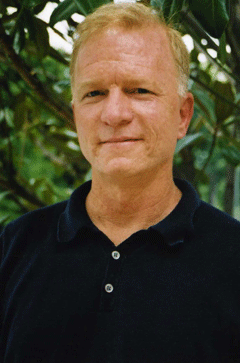
Eric Schaeffer (Courtesy of Eric Schaeffer)
SCHAEFFER: We had filed our lawsuit against Duke in 1999. In came the Bush Administration and basically shut us down. And now we’ve got the Supreme Courts saying the law that we were trying to enforce in fact, was good law and saying that unanimously. It's very satisfying. It is a sweet sweet victory.
YOUNG: But the court's decision does not end the dispute. The justices issued a narrow decision about how emissions should be measured under the law. That leaves other important arguments up to lower courts to figure out. So Duke and other companies can fight on. Schaeffer insists it's worth the fight when you consider the dangerous pollution at stake.
SCHAEFFER: This is very much a public health issue. If you win a New Source Review case you get a major cleanup and you get healthier air as a result.
YOUNG: Not so according to the EPA official who helped rewrite New Source Review.
HOLMSTEAD: The people who say those things don't understand how the clean air act works. This case and the decision by the Supreme Court will probably have no impact whatsoever on emissions from power plants.
YOUNG: That's Jeff Holmstead, he’s now with Bracewell and Giuliani, a K street firm that represents the energy industry. Before that he was top air pollution regulator for the Bush EPA. Holmstead says New Source Review had become so complex it no longer worked. He says companies didn’t know what the law was and were so afraid of lawsuits they couldn’t upgrade facilities to improve efficiency.
HOLMSTEAD: My job was not to create more lawsuits, it was to do the best possible approach for cleaning up the air.
YOUNG: The EPA position was much in line with what industry desired. Is that just a coincidence or was it indeed making changes on behalf of industry interests?
HOLMSTEAD: What we were all about, and what I hope the agency is all about, is to be making the right decisions from public health perspective. And after a lot of analysis we largely agreed that the industry was, in this case, was correct.
YOUNG: Holmstead says while the cases against Duke and others drag on, other regulations the administration started are already at work. He points to the Clean Air Interstate Rule, which is already cutting pollution. Eric Schaeffer says that’s still no excuse for undermining New Source Review.
SCHAEFFER: They came in arguing: enforcement doesn’t work and they did everything they could to make sure it didn't work. Had this administration not come in and weakened enforcement these plants would already be getting cleaned up.
YOUNG: The EPA's New Source Review changes are not complete. And it's not clear how the Duke case will affect the Agency's effort. Some states and environmental groups sued to stop them and one of those challenges could well end up back in the Supreme Court. So, what will become of New Source Review? Maybe EPA administrator Johnson's non-answer is the best answer we have.
JOHNSON: Stay tuned, stay tuned.
For Living on Earth I’m Jeff Young in Washington.
[MUSIC The Mercury Program “Tequesta” from ‘A Data Learn The Language’ (Tiger Style - 2002)]
Related links:
- Supreme Court decision in Environmental Defense v Duke Energy
- EPA information page on New Source Review program
- Environmental Integrity Project on New Source Review
CURWOOD: Coming up - a new study links asthma to persistent toxic chemicals. That’s just ahead right here on Living on Earth.
[MUSIC: Drift “Infusion” from ‘Mana Medicine’ (Liquid Sound Design - 2005)]
New Studies Link Asthma, Prostate Cancer to Toxic Chemicals

CURWOOD: It’s Living on Earth. I’m Steve Curwood. Despite advances in modern medicine two epidemics seem to be growing; those of prostate cancer and of asthma. Now there are some provocative new studies that link these diseases to exposure to tiny amounts of pollutants. One study finds that low-level exposure to the chemical bisphenol A found in some plastic bottles and some food cans can promote certain prostate cancers. That study has just been published in the Journal Molecular Cancer Therapeutics.
The other study indicates tiny amounts of pesticides and PCBs that mimic estrogen can stimulate the process of allergic reactions, most notably asthma. That’s reported in the current issue of Environmental Health Perspectives. Joining me now to talk about this emerging research is Dr. Pete Myers. He’s the chief scientist for Environmental Health Sciences, which publishes the online journal Environmental Health News.
Hello, Dr. Myers.
MYERS: Hi Steve, how are you today?
CURWOOD: Good. Now the first study we’re going to look at, the researchers for this one found a link between certain environmental contaminants that mimic estrogen and allergic reactions including asthma. What’s going on here?
MYERS: Well the big question out there is why are so many allergic diseases increasing. Asthma’s increasing. Allergies to things like peanuts is increasing. It’s really an epidemic of allergic disease. And scientists have been looking for clues about what could be driving this. And this new study shines a very bright light on one possible explanation. Our immune system depends upon estrogen signals to adjust how sensitive it is. A little bit more estrogen and your immune system becomes a little bit more sensitive. And so what these scientists did, was a different type of question. They recognize that there are actually chemicals in the environment that behave like estrogen. And so they began to perform a series of experiments where they took cells from mice and from people and they looked at the effective exposure to these estrogenic chemicals on the sensitivity of the cells immune systems. And low and behold they found a very very strong effect.
CURWOOD: So what kind of environmental contaminants are we talking about here? Where are they found and how do they wind up in our bodies?
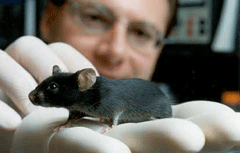
In one study, human prostate tumor cells were implanted in mice, which were then exposed to Bisphenol A. (Courtesy of NIH)
CURWOOD: Now, why has it taken so long to figure this out? What is it about the effects of these chemicals that makes it hard to see the link between allergic reactions and these chemicals that act like estrogens?
MYERS: Well first of all you have to think that the question is relevant. And it’s taken a while for the scientists who work on these types of issues simply to ask about the potential contribution of estrogenic substances to allergic disease. But now that they’ve started asking the questions they’ve discovered a very interesting aspect of how these contaminants alter immune system function. What they’re seeing is that really low doses ratchet up immune system sensitivity but that higher doses shut it down. And that dose response relationship is both something that’s relatively new to toxicology but it’s also one that’s hard to investigate.
CURWOOD: So, wait a minute. You’re telling me that someone who was exposed to a lot of DDT it wouldn’t have affected their allergic response to something but if it was just a little bit it would?
MYERS: Well, it isn’t so much that a high dose wouldn’t have affected it. A high dose would shut it down. Think about the surge protector that you use for your computer. Your computer needs electricity but if all of a sudden too much comes through it shuts down the system. Well that’s the sort of thing that appears to be happening here. Our immune system has to be able to respond to the signals that the body naturally sends it. Those signals are taking place at really low levels. As they increase the reactivity of the immune system rises. But if all of the sudden there is a surge that’s unexpectedly high, the system shuts down and that’s what appears to be happening.
CURWOOD: So that is very confusing if you’re doing research and you’re just looking at the chemical and its effect it’s paradoxical. Sometimes it works and sometimes it doesn’t.
MYERS: It is. It’s been one of the great challenges to research in this area and especially to how we go about establishing health standards. Typically the toxicological tests that are used to figure out whether this compound is safe and at what level it is safe. They begin at high doses and then they work down until they don’t see an effect. Well if the chemical that you’re working on at low doses causes an increase and at high doses causes a suppression you’re not going to be asking the right questions.
CURWOOD: Dr. Myers I know the study didn’t look at this at all but the asthma epidemic is really big in cities and really big among poor people. What questions would you want to ask as a researcher to link that prevalence of disease in those populations to what is being found in this research?
MYERS: That’s a great question, Steve and all the science isn’t in on the answer yet. But there are a couple of clues that we can take from this. One is that the biggest source of exposure to these things is dietary. Diets that are high in fat are more likely to expose you to some of the persistent contaminants that this study focused on. The other thing that science is pointing toward is the fact that cheaper grade construction materials often contain compounds that the science links to increased immune system sensitivity.
CURWOOD: In other words your house could be causing you asthma.
MYERS: Your house definitely could be causing you asthma. There have been some very interesting studies looking at the composition of dust in houses and the relationship to risk of asthma and there are significant associations being found.
CURWOOD: And so what does this research suggest? I mean, what’s the big picture here in terms of asthma?
MYERS: Well, the big picture is this: we know that we’re in the middle of an asthma epidemic. And people have been struggling with the question. Why are we seeing this? Why is asthma increasing at a time when for the most part air quality has been getting better? The answer this study suggests is it isn’t that there’s more pollution, it’s that we’re more sensitive to the pollution that’s there. Our immune system is responding more strongly to the irritants that have been around the whole time. It’s just that we’re more sensitive to them now.
CURWOOD: Let’s take a look now at that other study that considers tiny doses of toxic substances and this is the one that links prostate cancer to bisphenol A, which is commonly found in plastic bottles and the lining of some food cans. Now I understand that this study shows that tiny amounts of the toxin can interfere with a common treatment for prostate cancer. How did they come to that conclusion?
MYERS: What these scientists did was they implanted prostate tumor cells from people into mice. And then they looked at the effect of exposing those mice to bisphenol A. And what they found was that bisphenol A made the cells switch into a state where they couldn’t be controlled by the normal way physicians manage prostate cancer.
CURWOOD: How could BPA interfere with prostate cancer treatment?
MYERS: Well, normally when a guy has prostate cancer it turns out that those tumors need testosterone to divide and grow. And that’s a condition that’s called Androgen Dependence. Testosterone is an androgen. So, if the physician can either lower the guy’s circulating testosterone levels or somehow make him less sensitive to testosterone using pharmaceuticals they can keep the tumor under control. So what this new science tells us is that if the tumor is exposed to bisphenol A, it shifts. All the sudden it’s no longer dependent on testosterone to proliferate.
CURWOOD: How do you avoid bisphenol A? I understand it’s in 95 percent of us.
MYERS: It’s in 95 percent of us but not all at the same levels. I’ve taken one very practical step which is I avoid canned food. I also don’t use those wildly popular sports bottles that are made out of polycarbonate plastic. There are ways that individuals can decrease their exposures. There’s no question about that.
CURWOOD: Ok, so we’ve got this one new study from the University of Cincinnati that finds a link between bisphenol A and prostate cancer. And then we’ve got the other new study from the University of Galveston that we talked about earlier, linking some persistent organic pollutants with asthma. So, tell me Dr. Myers what do these two studies say about the chemicals we’re being exposed to on a daily basis and our general health.
MYERS: Well they say two things. They say that the health standards that we have developed over the last 30 years are in the scientific Jurassic. They just haven’t been asking the right questions. But they say something else which I find very encouraging. The science is telling us that if we pay attention to it and we start making individual choices and societal choices about how we manage these chemicals and how we work to avoid exposures we can probably prevent some of the diseases that here to for we hadn’t thought were preventable. That’s pretty exciting.
CURWOOD: Dr. Pete Myers is chief scientist for Environmental Health Sciences in Charlottesville, Virginia. They publish Environmental Health News. Thank you so much sir.
MYERS: Thank you, Steve.
CURWOOD: You can find references for this research and a link for the Environmental Health News site at loe dot o-r-g.
[MUSIC: T-Rek “Drug Punk Lady” from ‘Rubber Records Sampler 2007’ (Rubber Records - 2007)]
Related links:
- Environmental Health News-Prostate Cancer & Bisphenol
- "Bisphenol A facilitates bypass of androgen ablation therapy in prostate cancer" in Molecular Cancer Therapeutics
- Environmental Health News-Asthma & Allergies
- "Environmental Estrogens Induce Mast Cell Degranulation and Enhance IgE-Mediated Release of Allergic Mediators" in Environmental Health Perspectives
Aussie Miners Tackle Global Warming

Greenpeace activists shutdown Kooragang Island coal loader in Newcastle, the NSW's largest coal loader, in an effort to warn people about the government's expansion plans for the coal industry. The coal industry is one of the biggest causes of climate change. (Photo: (c) Greenpeace)
CURWOOD: Australia and the United States are the only two industrialized countries that have so far refused to ratify the Kyoto treaty that puts a cap on global warming gases. A dependence on heavily polluting coal is a major reason why. Just about half of US electricity comes from coal, and Australia is the world’s largest exporter of coal. Faced with tight carbon restrictions under Kyoto, the coal industry in both nations has been leery of the treaty. But now the union that represents Australian coal miners is taking a different approach. It’s calling for a bold strategy to fight global warming. Mark Tamhane has our report.
[GREENPEACE RAID]
TAMHANE: Coal is Australia's most lucrative export. Now it's become highly controversial as well.
[GREENPEACE RAID]
TAMHANE: In February this year activists from the environmental group Greenpeace filmed themselves disabling a coal-loading facility in Newcastle. Located at the river mouth of the Hunter Valley, the city is the world's busiest coal export gateway. Greenpeace Australia's Energy campaigner is Ben Pearson.
PEARSON: Four activists entered the terminal, pulled the safety chain, which shuts down the conveyors and then locked themselves to the conveyer. They were able to stay there for two hours and we estimate to stop the loading of about 14-thousand tons of coal. When you burn coal you get greenhouse pollution, which fuels climate change. That is the greatest threat we face on this planet. That is why coal is deadly.
TAMHANE: These actions and the publicity they generate, make Tony Maher furious. He's the president of the powerful Construction, Forestry, Mining and Energy Union- the CFMEU. It represents nearly all of the workforce in Australia's coal mining and power generation industries.
MAHER: You go round the mining communities and people tell you that they're effectively demonized. The local papers are always saying that the industry should be closed down or stifled in some way and that coal mining is the cause of the drought, and global warming, and, so people do feel very uncomfortable about that. Miners' families, kids, get taught at school that coal mining's a bad thing.
TAMAHANE: Tired of being painted as out-of-touch environmental vandals by groups like Greenpeace, the coal miner's union has decided to adopt its own climate change policy. Maher claims it's the most progressive stance by any coal miners' union in the world.
MAHER: Well, our policy is pretty simple. Ratify Kyoto, increase mandatory renewable energy targets- it's a paltry two percent now, it should go to five and ten percent, and perhaps beyond. Miners should have no fear about renewable energy, um and there should be a price signal on carbon- that's best done through a carbon-trading scheme. We support that.

Underground mining in Australia- the world's largest coal exporting nation. (Courtesy of Australian Coal Association)
HOWARD EX PARLIAMENT: You'll never be able to generate base-load power using solar and wind. I mean the only things that will ever replace the current dirty power stations are, ah, cleaner uses of fossil fuel or nuclear power.
TAMHANE: With no existing nuclear power stations in Australia, or on the drawing board, that means coal will be king for a long time to come.
[SOUND OF TRUCK REVVING UP, LOAD OF COAL IS DUMPED]
TAMHANE: At the other end of the Hunter Valley lies Bulga coal mine. Here, giant machines rip at the black ground, while trucks three stories high cart away tons of coal. The scene is repeated 24 hours a day, seven days a week at this open pit mine. Mechanic Lloyd Hill keeps these giant machines going- something he’s done for 25 years.
[SOUND IN COFFEE SHOP, CHATTING IN BACKGROUND]
TAMHANE: Relaxing in a coffee shop after a long shift, Lloyd Hill says he'd still recommend coal mining as a career.
HILL: I enjoy the work, it's hard work. The biggest challenge is the hours, the 12-hour shifts, it's long and tedious, but I think it's something most people would stay with. Certainly I would recommend it for most people to go into, as long as they have the will to do the job.
TAMHANE: But there's no getting away from the fact that under current technologies each ton of coal mined at Bulga will produce up to two and a half tons of greenhouse gases when it's burned. And there are growing calls for people like Lloyd Hill to be the last generation of Australians employed in coal mining. So there were raised eyebrows when Hill and his coworkers first heard about the union's proposal for a Greenhouse policy.
HILL: Initially, when the first reaction is the workforce see it as losing jobs, but once you explain to them that it's the way of the future, the way that it needed to be and that it's a proactive stance by the union, they come around. And the mine where I worked at, it was 100 percent supported.
TAMHANE: The Union's new platform states that the nation has a moral obligation that extends beyond its borders. Australia should help developing countries burn its coal in the cleanest possible way. On this point, the union and the government agree. Prime Minister Howard says the greatest contribution Australia can make in the fight against global warming is to export homegrown "clean coal" and carbon capture technologies to energy-hungry countries like China and India. Even though experts agree these innovations may not be commercially viable for years. So who is going to pay to develop this technology? The president of the Construction, Forestry, Mining and Energy Union, Tony Maher, says it should be the coal mining and power generation companies.
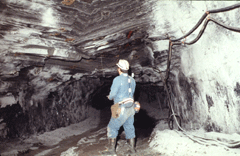
Surveying horizontal stresses in an Australian coal mine. (Courtesy of CDC)
TAMHANE: The National Coal Association declined to be interviewed on tape, but a spokesman said the industry's spending considerably more than 300 million dollars on "clean coal" development. Meanwhile, the miner's union has bought shares in all the major coal companies, so members can attend shareholder meetings and argue for more investment in "clean coal." It's pressing U.S. and European pension funds to do the same with coal companies that have Australian operations.
Tony Maher is adamant the union's sudden interest in being Greenhouse friendly, isn't motivated by more mercenary aims...like a new membership drive.
MAHER: In terms of renewables, it's been put to me many times that we should support wind farms or solar panels and we should try to get coverage of those workers. My view is that we need to develop a good position for all the right reasons, not for the wrong reasons, so we won't do that.
TAMHANE: Tony Maher is blunt.
MAHER: Look I think we'll stay the concrete it, chop it down, dig it up, and burn it union!
[SOUND OF TRUCKS]
TAMHANE: For Living on Earth, I'm Mark Tamhane in Australia's Hunter Valley.
Related links:
- Construction Forestry Mining and Energy Union (CFMEU) Climate Change Policy
- Tony Maher's biography
- XStrata Coal: the location of Bulga Coal Mine
- Australian Coal Association
- Coal 21 (the $300 million fund the Australian Coal Association has set up to investigate clean coal)
CURWOOD: Coming up, flying low over the Sea of Cortez through the spout of a blue whale. It’s Living on Earth. But first this note on emerging science from Meghan Vigeant.
Emerging Science Note/Double Duty Plastic?
VIGEANT: Scratching your head about what alternative fuel could go into your gas tank? What if there was a fuel you could use twice? Richard Gross, a chemist at Polytechnic University in Brooklyn, has developed a plastic that can easily be converted to fuel. The plastic is made from vegetable oil, the same stuff that makes biodiesel. But instead of going right to the fuel tank, Gross’s new substance can double as a Tupperware container first.
The fatty acids in vegetable oil are used to create the bio-plastic. Gross developed a process to convert the fatty acids into polymers, long chains of similar molecules, sort of like pearls on a necklace. And polymers are the main ingredient in plastic.
The conversion of plastic to fuel is then relatively low tech. All it takes is a shredder, warm water and an enzyme called cutinase. The enzyme breaks the polymers into separate pearls. And after a few days the plastic dissolves into liquid biodiesel.
The plastic isn’t commercially viable yet, but the potential to turn plastic trash into easy fuel has got the attention of the Pentagon. The average soldier generates seven pounds of plastic waste a day, including their notorious field rations, the plastic wrapped MREs, or Meals, Ready to Eat. If they used bioplastic wrapping, these soldiers could each turn that trash into one gallon of fuel per day. Now there’s a plastic that does double duty.
That’s this week’s note on emerging science. I’m Meghan Vigeant.
Related link:
More about Richard Gross
CURWOOD: And you’re listening to Living on Earth.
Support for the environmental health desk at Living on Earth comes from the Cedar Tree Foundation. Support also comes from the Richard and Rhoda Goldman Fund for coverage of population and the environment. This is Living on Earth on PRI—Public Radio International.
[MUSIC: Lisa Walker “Orca Drift” from ‘Mana Medicine’ (Liquid Sound Design - 2005)]
Eco-Pilot
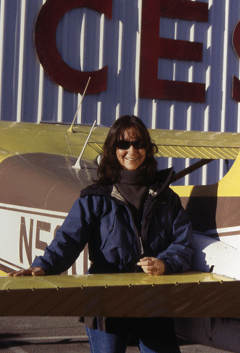
Sandy Lanham poses in front of her 1958 Cessna plane. (Photo: Kaye Craig)
CURWOOD: It’s Living on Earth. I’m Steve Curwood. Living on Earth started its weekly broadcasts sixteen years ago this month. And to mark our anniversary, we’re taking a fresh listen to some of the award-winning reports we’ve aired over the years, and to get caught up with the people and issues at the heart of the stories. This week we head back to 2001, and toward Mexico’s Sea of Cortez, also known as the Gulf of California.
That’s where reporter Barbara Ferry found Sandy Lanham, swooping low over the water in a 45-year-old Cessna to help track endangered wildlife. Our story won a Gracie Allen Award from the Foundation of American Women in Radio and Television. And soon afterwards Sandy Lanham herself won a MacArthur Genius grant for her work. We’ll talk with Sandy Lanham in a few minutes, but first, let’s take a listen to “Mexico’s Eco Pilot.”
The story was produced by Barbara Ferry of Homeland Productions.
[SOUND FROM AIRPORT]
FERRY: Sandy Lanham walks around her tiny airplane doing a safety check before taking off from La Paz' airport. Her long brown hair whips around her face as she leans over the propeller on the windy tarmac, surrounded by giant Aero Mexico jets taking off and landing.
LANHAM: Feel the propeller, in case a stone hit it the last flight. See if there's any nicks or cracks or anything bad.
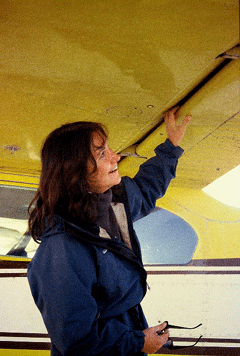
Sandy checks things over before heading up.
(Photo: Kaye Craig)
LANHAM: I like that it's an old airplane, and I think it's doing the best work of its life, at the end. It appeals to me, gives me hope. I tell people it has bad paint and a good heart. [Laughs]
FERRY: Sandy Lanham founded Environmental Flying Services after working as a flight instructor, a social worker, a belly dancing teacher, and a print saleswoman. She says it was just good luck that she realized she could create a new career out of three things she loves: Mexico, wildlife and flying.
LANHAM: I was living in Mexico for ten months. I had bought an airplane, didn't know what to do with it, had to do something with it, could not afford it. And I went away for the weekend, and when I got back the kids ran up to me – kids living on the block in this Mexican little town – and said, The police are looking for you, the police are looking for you. And, yeah, it scared me.
FERRY: As it turned out, it was the environmental group Conservation International that had asked the police to track down Lanham. The group was looking for a pilot to help with a research project over the Gulf of California. That flight led to others, and Lanham soon found out that researchers were desperate for pilots. Now, 11 years and thousands of miles later, she makes a quick stop into the airport office to file her flight plan, before taking off on today's mission.
[SPANISH SPEAKING]
FERRY: Today we'll be flying over San Jose Channel, a narrow waterway between the Baja Peninsula and a tiny island. Our mission is to track blue whales, part of a long-term study to understand the importance of the gulf to these largest mammals on Earth. Diane Gendron, a biologist with the Interdisciplinary Center for Marine Sciences in La Paz, heads the study. Armed with binoculars and a camera, Gendron climbs on board, next to Lanham.
[SOUND OF PLANE STARTING]
FERRY: We take off, leaving behind the brown desert city. Soon we're flying, though it feels more like floating, above the brilliant jewel-like sea.
LANHAM (in plane): Boy, look at the view of that lagoon, with the mountains, brown mountains, reflected in the water. It's incredible.
GENDRON: Yeah, that green, red.
FERRY: The ocean is like a thick soup of marine life. Everywhere we look, we see something. Gendron and Lanham point out schools of dolphin and mackerel, along with fin whales, hump backs, a sperm whale, even a rarely seen Sei whale.

The eco-pilot in action! (Photo: Kaye Craig)
GENDRON: It looks like a blue whale.
LANHAM: Oh.
FERRY: The blue whales are about 80 feet long, four times bigger than our plane. But as we lean out the open windows, they look like small steamships chugging along in the water.
LANHAM: Looks blue.
GENDRON: It's the blue, isn't it?
LANHAM: Yeah.
GENDRON: Turquoise-lime.
LANHAM: Yeah.
GENDRON: They're so easy. What a pretty place for it to be.
FERRY: Some days, Lanham flies for hours and hours without seeing anything, and though she says the absence of wildlife is valuable information, Lanham admits it's more fun when she circles down low to get a close look at something.
GENDRON (in plane): There's something out here too. Oh, it was a fluke. I think it's the humpback.
LANHAM: Sometimes, you fly so low or you drop down so low because of an updraft or, I'm not sure what. You know, all the spout, the blow of the whale, drifted through the open window. I mean, we were literally wiping a blue whale's breath off our faces. [Laughs] Our faces were wet with blue whale breath.
FERRY: Getting this close to the water can be perilous, and there are other dangers: fog can roll in suddenly, tiny stopover airports can run out of fuel. Lanham keeps a life raft on board, as well as a marine radio. And affixed to the dashboard she has a medallion of San Ysidro Labrador. He's the saint Mexicans pray to for rain. Lanham prays to him for no rain, at least not while she's flying.
LANHAM (in plane): I'm going to see if I can get rid of this tower -- there's something else right ahead, let's do him first. Something I'm going to put on your side.
FERRY: During the 700 hours or so she spends in the air each year, Lanham sees wildlife in places no one imagined. Her sightings of threatened shore birds, rare turtle nests, and endangered pronghorn antelope, have helped win critical habitat protection for these species. And Lanham sees animals behave in ways that surprise even the scientists who spend their lives studying them. Just yesterday, she saw a gathering of hundreds of sharks in the water, a sight that baffled marine biologists. Even more common behavior can be a remarkable site from 1000 feet up.
LANHAM: You fly over an area that looks just like when you lift the lid on your washing machine when it's in the agitate cycle, let's say, on the dark clothes. You see your Levi's and you're not quite sure which is a leg and which is a button. That was kind of going on. You know, I didn't know what was happening. And then, kind of my confusion cleared up pretty quickly. I understood that this was a copulation circle, which took at least three animals – male, female, and a juvenile male, who was helping to hold the female up against the male, holding the animals together so they could copulate.
[IN AIRPLANE:]
LANHAM: It is a definite nine, way point 819. Good. And she's going down. Oh, she's a fluker, she's a fluker. Great.
FERRY: Lanham uses a satellite-based global positioning system to record the exact position of all the whales she and Gendron see. Later, Gendron will hook up the GPS to her computer, to download the information for each whale they've spotted.
LANHAM: Up! And I got a sperm whale, right underneath me.
GENDRON: I have a blue whale, too, when you have a chance.
LANHAM: The sperm whale is a 35, one sperm whale.
GENDRON: A 20?
LANHAM: Yes. For you.
FERRY: After four hours in the sky, we head back to the airport.
[AIRPORT SOUNDS]
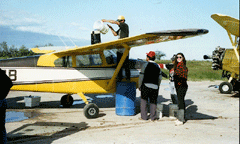
The crew refuels the plane by hand before heading out. (Courtesy of Sandy Lanham)
FERRY: Back on land, Lanham remembers wanting to be a pilot ever since she was a young girl growing up outside Detroit. Although she loved exploring the woods near her house, the tall trees of Michigan made her feel claustrophobic. She imagined herself flying high up above them, with a long view of the earth. But it wasn't until she became a mother and was going stir crazy at home with her daughter that Lanham signed up for flying lessons.
LANHAM: And after about a year of this, she was in nursery school, and the teachers were having the kids write little books, and it was about what mommies do, what daddies do. And her little book which she brought home was: Daddies go to work, read the books, drive the cars. Mommies take care of the kids, cook the foods, and fly the airplanes. [Laughs]
FERRY: Since those early days, Lanham has learned a lot. She's now known as one of the best bush pilots working in Latin America. And research colleagues, like whale biologist Diane Gendron, say they inherently trust her.
GENDRON: Since the first time I flew with Sandy, I felt very safe. And when she hear me saying that, she always look at me and say, "You can't say that, because it's not safe to fly, you never know what's going to happen." But what I mean by that is that I feel that I am in good hands.
FERRY: Lanham is so devoted to her work that friends joke she should wear a sign that says, "Will fly for food." And it's true that, even with all the time she spends writing and occasionally landing grants, Lanham makes a lean living at times. But her clients say Lanham's services are invaluable. Jorge Canzino, of the Center for Biological Research in La Paz, studies endangered pronghorn antelope in the deserts of Baja, California.
CANZINO [SPEAKING SPANISH]
VOICEOVER: Without her, we don't fly. Maybe we would look for other options, but with the costs and with the way we work, there really isn't any other way.
FERRY: As an American working in Mexico, Lanham feels frustrated that environmental groups are relatively well funded in the United States, while those south of the border struggle to survive. As she flies back and forth across the border, that political line is as invisible to her as it is to the wildlife which migrate across it.
LANHAM: The border is relevant only to a political system, but if you want to protect ducks in the United States, you have to protect their wintering ground in Mexico. If you want to protect whales, I'm not trying to protect Mexican whales. These are whales that don't recognize the border, not part of their DNA, let's say.
FERRY: After a day of flying, Lanham gathers with her colleagues at a restaurant in La Paz. Over seafood, margaritas, and cigarettes, she entertains them with tales of her airplane adventures. Sometimes, even bathroom stops can be dangerous.
LANHAM: We're in the bushes, when I notice that there are four men like running down the runway towards us, with guns. With guns. Right. And so we then, you know, I'm pulling my pants up as I'm running back into the airplane, climbing in, he climbs in, doors shut, no back taxi, no engine warm-up, just crank the thing on and go. I mean go.
FERRY: Running into narcotraficantes, or being mistaken for a drug runner by the Mexican Air Force, are the kinds of adventures Lanham says she'd rather avoid. Of course there are plenty of times when flying is just tedious and exhausting.
LANHAM: When you're flying pronghorn surveys, you're half asleep half the time; it's so boring. Then all of a sudden, out of the corner of your eye, you know, you've got – you catch a movement, and it's an animal that's running, second fastest running animal in the world. It's moving like a sail. And, um, you see a group of ten and I guess you kind of wonder how so much life, you know, and how much energy can happen, in a place that's so still.
FERRY: It's moments like these which help explain why, despite the low pay and risks, Lanham thinks she has the ideal job. Some might call it a crazy career choice, but she says she's one of the lucky ones.

Sandy Lanham poses in front of her 1958 Cessna plane. (Photo: Kaye Craig)
LANHAM: If there's any, like, goal in life, it's just to like find out what it is that you can do well, put it together in a way that you can both enjoy your life and also do some good, do something that matters. I mean, how can you be any better than that?
FERRY: For Living on Earth, I'm Barbara Ferry, in La Paz, Mexico.
CURWOOD: A lot has changed in the world since we first aired the story you just heard. But the mission is still the same for Sandy Lanham. We tracked her down in Tucson, Arizona, and Sandy, I understand you’re still flying?
LANHAM: Oh, yeah. I was just flying yesterday.
CURWOOD: What do you see now some six years later in terms of the animals you were observing before? What’s life like now for the whales of Baja California?
LANHAM: Well, it was interesting listening to this program, which I haven’t listened to in a long time because last week I came back from working with Diane Gendron who was in Barb Ferry’s story. And I’d like to report that mostly because of her work we now know that the Gulf of California is the only known nursery for the entire North Pacific population of blue whales. No other place in the Pacific, that we know of, where whales come to raise their young and perhaps even give birth.
CURWOOD: Listening to this story again I was caught again by the story of the shark school. How are those animals doing?
LANHAM: You know I was not flying for sharks. This happens all the time. I was flying for something else. Actually I don’t quite remember. It was probably for whales. And so we came across this huge aggregation of maybe 600 sharks. And I eventually reported it to a shark institute in Florida. And the experts there believe that they were probably silkies. Which was really interesting because the man casually informed me that they didn’t actually, wouldn’t have guessed that there were that many in the entire Gulf let alone in one ball, which is what we saw. So it was probably some kind of breeding activity that just nobody happened to be in the right place at the right time to observe before.
CURWOOD: So, Sandy, soon after this story aired you received the MacArthur Genus Grant for your work as an eco-pilot. What did you do with the money?
LANHAM: (laughs) Well, I think the money kept me in operation. One thing that I’m not sure if anybody knows is just how on the edge I was. People would ask me if I had funding for the next year and it’s usually that I didn’t have funding for the next week. And so after the MacArthur money started coming in I didn’t have those worries anymore.
CURWOOD: Did you get yourself a new airplane?
LANHAM: Actually it took me a couple of years to do it but I did get a new, at least new to me, airplane. And I moved up in the world, I actually retired that 1956 airplane and I got a 1958 airplane.
CURWOOD: Oh, wow, ok.
LANHAM: Oh, no, no, no I wanted that. I liked it.
CURWOOD: Uh huh.
LANHAM: If I had all the money in the world I wouldn’t get one of the newer ones.
CURWOOD: BB King has a song, The Thrill is Gone. But it doesn’t sound like to me that the thrill of being in the air is gone for you.
LANHAM: Actually the thrill is not gone. You know, actually the flights in the last three weeks have been as close as you can come to perfect. Um, which to me means no mechanical problems, um good weather. We’ve had a window of good weather that allowed them to be completed. And especially the work with Diane, the blue whale researcher was just fantastic. So the thrill is not gone. I just think I found my niche in life and I’m going to be happy with this until I die.
CURWOOD: Sandy Lanham is an eco-pilot with her company Environmental Flying Services. Thank you so much.
LANHAM: Thank you.
CURWOOD: And keep flying.
LANHAM: (laughs) tomorrow.
[MUSIC: Lisa Walker “Transfixed” from ‘Grooved Whale’ (Earth Ear - 2001)]
Related link:
Environmental Flying Services
CURWOOD: Next week on Living on Earth we continue our retrospective series and revisit a question we first raised in an award-winning story from a decade ago. It’s the perfect food for infants, but what about all the toxins that can also be carried in human breast milk?
DELEON: That evening, when my son fell back, milk drunk and ruddy cheeked in my arms, I carried him upstairs with a sense of unease. Was he really as all right as he looked? I needed to know if my milk contained chemical time bombs that might wait half his life to go off.
CURWOOD: Breastfeeding baby: A modern dilemma next time on Living on Earth.
[MUSIC WITH WHALES]
CURWOOD: We leave you this week with an unusual sort of “pod” cast.
[MUSIC: “Orca Slide Guitar & Orca Reggae” recorded by * Jim Nollman from ‘Orca’s Greatest Hits: Playing Music With Whales’ (Interspecies.com – 2007)
* Excerpts also: Jim Nollman “Realtime Interspecies Music” from ‘Belly of the Whale’ (Important Records – 2006)]
CURWOOD: A few years ago a group of musicians set out to try to communicate with whales by playing music to them underwater. This recording captures a few samples of the experiment in which sperm whales, orcas, belugas and Humpbacks seem to be singing right along with the human music.
This ORCA-stral performance was created by musician and sound artist Jim Novell.
CURWOOD: Living on Earth is produced by the World Media Foundation. Our crew includes Ashley Ahearn, Eileen Bolinsky, Bruce Gellerman, Ian Gray, Ingrid Lobet, Jennifer Percy, Emily Taylor, Peter Thomson and Jeff Young - with help from Bobby Bascomb, and Kelley Cronin. Our interns are Paige Doughty and Meghan Vigeant. Dennis Foley is our technical director. Alison Lirish Dean composed our themes. You can hear us anytime at loe dot org. I’m Steve Curwood. Thanks for listening.
ANNOUNCER: Funding for Living on Earth comes from the National Science Foundation, supporting coverage of emerging science; And Stonyfield Farm organic yogurt, smoothies and milk. Ten percent of profits are donated to efforts that help protect and restore the earth. Details at Stonyfield dot com.
Support also comes from you our listeners, the Ford Foundation, the Educational Foundation of America and the Saunders Hotel Group of Boston's Lennox and Copley Square Hotels. Serving you and the environment while helping preserve the past and protect the future, 800-225-7676.
ANNOUNCER2: PRI, Public Radio International.
Living on Earth wants to hear from you!
Living on Earth
62 Calef Highway, Suite 212
Lee, NH 03861
Telephone: 617-287-4121
E-mail: comments@loe.org
Newsletter [Click here]
Donate to Living on Earth!
Living on Earth is an independent media program and relies entirely on contributions from listeners and institutions supporting public service. Please donate now to preserve an independent environmental voice.
NewsletterLiving on Earth offers a weekly delivery of the show's rundown to your mailbox. Sign up for our newsletter today!
 Sailors For The Sea: Be the change you want to sea.
Sailors For The Sea: Be the change you want to sea.
 The Grantham Foundation for the Protection of the Environment: Committed to protecting and improving the health of the global environment.
The Grantham Foundation for the Protection of the Environment: Committed to protecting and improving the health of the global environment.
 Contribute to Living on Earth and receive, as our gift to you, an archival print of one of Mark Seth Lender's extraordinary wildlife photographs. Follow the link to see Mark's current collection of photographs.
Contribute to Living on Earth and receive, as our gift to you, an archival print of one of Mark Seth Lender's extraordinary wildlife photographs. Follow the link to see Mark's current collection of photographs.
 Buy a signed copy of Mark Seth Lender's book Smeagull the Seagull & support Living on Earth
Buy a signed copy of Mark Seth Lender's book Smeagull the Seagull & support Living on Earth

